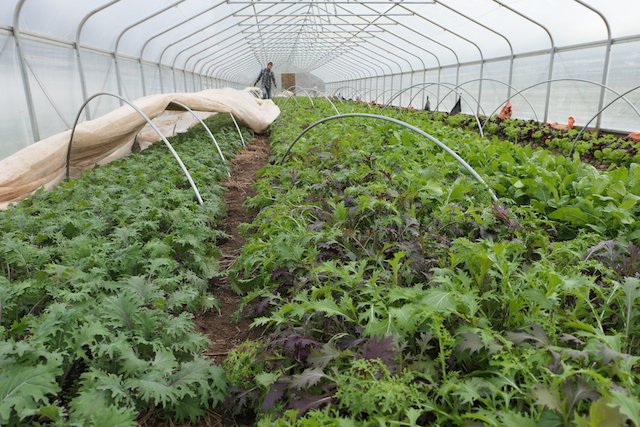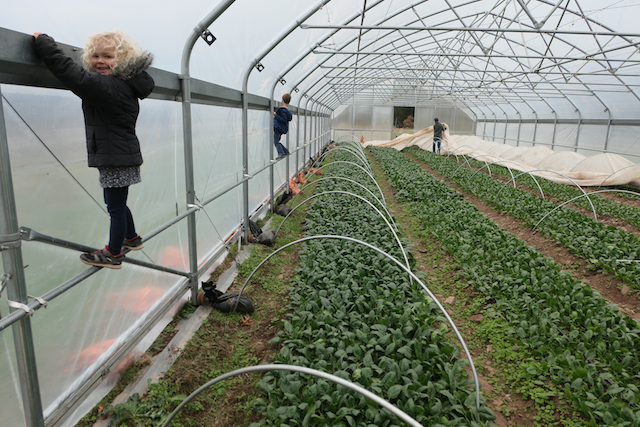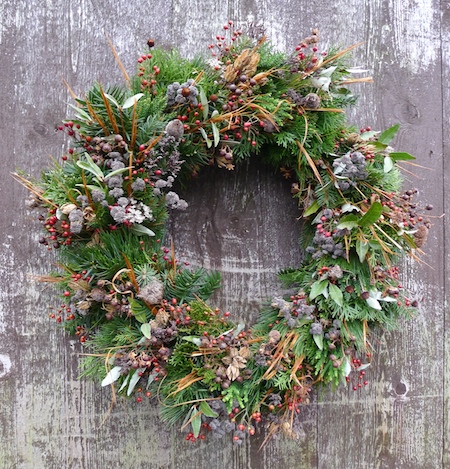
Late Fall CSA Week 2: Through A Cold Test
News
Expected Harvest
Mid-Autumn Mix
by Farmer Derek
Mid-Autumn Mix
by Farmer Derek

Uncovering the Hoop Tunnel after last weekend's cold plunge. Uncovered for a few days, it was then recovered last Tuesday in anticipation of the serious mid-week drop in temperatures. Proper airflow is required to keep plant disease at bay. We also don't want the plants too warm or they may not adjust to the cold as well.
Late Fall Harvest #2 (Week B) should include Napa cabbage, green cabbage, radicchio, potatoes, garlic, onions, carrots, kale, arugula, lettuce mix, beets, purple daikon, celeriac, kohlrabi, and hakurei turnips. Some items will be a choice.

Notes From The Field
Cold Season Challenges
by Farmer Derek
Cold Season Challenges
by Farmer Derek

Most of our interaction with crops these days takes place in our four tunnels. Frequent covering and uncovering and ventilation adjustment is common with fluctuating outdoor temperatures. Unfortunately when crops stay covered for a little while we're unable to properly monitor their growth and harvest potential so sometimes there's a bit of an unpredictable nature to harvest forecasting this time of year. Though we know for sure we'll be harvesting a decent bundle of greens to distribute each week, we're never 100% sure what variety and how much will be cut until all covers are off. Seen above are three successions of spinach in our movable high tunnel. Do to a slower growth rate and greater tolerance to cold, we'll probably wait to harvest spinach until the latter half of the Late Fall season.
It was an enjoyable challenge to begin this Late Fall adventure with some serious sub-freezing temperatures during the middle of last week. It seems we're now able to avoid much of the excitement and apprehension that we used to feel during these events when we first started pushing harvests into the colder season; we now know more of what to expect, how to plan, what to do, and how to properly ride out a freeze. Cold-hardy, cold-tolerant crops are amazingly resilient and if we give them just enough protection they can basically be grown all winter in unheated tunnels. Pretty remarkable I'd say. Not that they do so without meticulous care and plant-sitting, but even when it dips to zero outside, with a layer or two of fabric thrown over interior hoops, trapping earth's and the daytime sun's heat closer to the crops, that insulating layer is enough to pull crops through and keep temperatures above the damage threshold. During serious prolonged cold spells when temperatures might not rise out of the twenties during the day and drop to singles at night, crops may seriously freeze and take a few days to recover, but it's fairly amazing when they do recover. I've seen them frozen solid, wilting and bent to the ground, only to be perky and sun-thirsty a week later. There is a bit of initial infrastructure investment that goes into protecting them initially (the high tunnels) but once they're up, they can be used for many many years as well as during all the other growing seasons.
Besides managing the temperatures in the tunnels with layers and ventilation, we also have to monitor soil moisture and humidity levels. There's not much evaporation and transpiration this time of year so as of now I'm only irrigating about once every two weeks, down from every week just a month ago. With the off-and-on again cold I have to drain all the pipes when temperatures dip into the mid-twenties at night. At this time it looks like we're expecting warmer (average?) temperatures for the next 10 days, so now when I refill the pipes I at least won't have to drain the whole system right away.
While we know pretty well how to protect crops during cold, we're still working out how best to keep humans happy in an unheated barn. So far I'm a fan of (very) temporary relatively quick solutions using old tunnel covers and space heaters (function over form?). Though not exactly aesthetically pleasing it at least does the job of keeping the pick up room a balmy upper 30s or low 40s when outside temperatures sit below the freezing mark. In a perfect world we would install a wood stove and may do so eventually if we end up battling serious cold more frequently during the Late Fall season.

Late Fall Pick Up Information
by Farmer Derek
by Farmer Derek
- Pick up days are typically Wednesday 1-8pm and Saturday 11am-1pm. However...
- During the week of Thanksgiving, Late Fall Harvest Week #3, Wednesday's pick up will take place on Tuesday, November 26th to accommodate travelers and holiday schedules.
- During the week of Christmas, Late Fall Harvest Week #7, Wednesday's pick up will take place on Thursday, December 26th.
- You can temporarily switch your pick up day/week be notifying us by 5pm Sunday prior to your pick up day/week. If you miss your pick up we will contact you to reschedule.
- Bring your own bags to collect the produce.
- Check off your name on the sign in sheets just outside of the pick up room.

Farm-Foraged Wreaths For Your Holidays!
by Farmer Dana
by Farmer Dana
All wreath materials are foraged from Anchor Run Farm grounds and assembled by your farmers.
To order email danahunting@gmail.com, include ‘wreath’ as the subject line and let us know which wreath(s) you would like. All wreaths come with or without a bow (red or white) depending on your preference at no extra cost. You can take your wreath home on your farm pick up day, or you may coordinate an alternative wreath pick up day with Dana. Payment in the form of a check to Anchor Run CSA, or cash, can be made when you retrieve your wreath.
At the end of the holiday season (whenever that may be for you) we gratefully accept back your spent wreath to compost wreath materials and to re-use the wreath form for later seasons. Of course, if you have wreath-making aspirations of your own, please keep the form to enjoy yourself!

Classic Wreath - $35

Festive Wreath - $45

Harvest Wreath - $55


